By the time a visitor finds your product, you’ve overcome one of the biggest hurdles for eCommerce store owners. Out of all the millions of products, they’ve landed on yours!
But now they’re at a critical decision-making point, and it’s your job to guide them from casual interest to making a purchase. Ultimately, you want to convince them to add a product to their cart and check out.
To do that, you need to write product descriptions that not only describe what you’re selling, but also connect with your customers on an emotional level.
Good copy (jargon for marketing-related writing) isn’t easy to write, but it’s worth making the effort or hiring a professional because product descriptions have such a profound impact on the conversion process.
According to data shared by OneSpace, as many as 98% of consumers have been dissuaded from making a purchase due to a lack of product information.
That paints a grim picture for brands that don’t put much effort into writing their product descriptions.
In this article, we’ll dig into why product descriptions matter, how words impact conversions, product description best practices, and tips to help you write high-converting product copy for your WooCommerce store.
Why Better Product Descriptions Are Worth the Effort
While shopping, consumers process a lot of information. It’s an emotional, physical, and psychological experience.
With online shopping, the physical aspect is removed because consumers can’t hold the product in their hands to examine it. They’re left to rely on visual cues and the information you provide to help make a purchase decision.
Price is only one part of the purchase decision, and it takes more than just a collection of product features and specs to satisfy the customer’s need for info.
A great product description clearly states the value and benefits of the product, tells a story, and presents the product as something more – a solution.
In short, a good product description mirrors the thoughts, desires, and needs of your target audience.
When brands fail to accomplish that connection, the consumer goes elsewhere.
According to a report from Shotfarm, poorly written product pages:
- Weaken trust and confidence in a brand for more than 80% of consumers
- Result in more returns, with 40% of consumers returning products due to inaccurate descriptions
While this post focuses specifically on psychology, keep in mind that there are other important factors to consider when writing product descriptions:
- Organic Search. The majority of customers start their search for a product using search engines like Google. Well-written, optimized product descriptions are more likely to appear in those organic searches, resulting in a higher volume of targeted and ready-to-convert traffic.
- Internal Search. By writing more robust product descriptions, you increase the chances that the product will show up in internal searches using a variety of different terms. Spend some time testing your search functionality using keywords like “learning toys for kids” rather than a specific product name. If you don’t like the results or you simply want to take your search experience to a new level, consider extensions like WooCommerce Product Search
- Paid Campaign Optimization. Paid ads typically use some kind of quality score to calculate the cost per click, action, or engagement. A well-crafted and optimized product description is likely to result in a better quality score to your target audience as well as to the ad it’s linked to.
The Psychology of Better Product Descriptions
A really great product doesn’t generate sales on its own. A customer needs to have at least a basic understanding of how the product works. More importantly, they need to understand how that product will help them.
According to Harvard Business professor Gerald Zaltman, 95% of purchase decisions take place subconsciously.
While a customer makes a conscious decision whether or not to purchase a product, that decision is influenced by their subconscious. When you understand some basic principles of psychology, you can begin writing better product descriptions that help guide more customers toward a purchase decision.
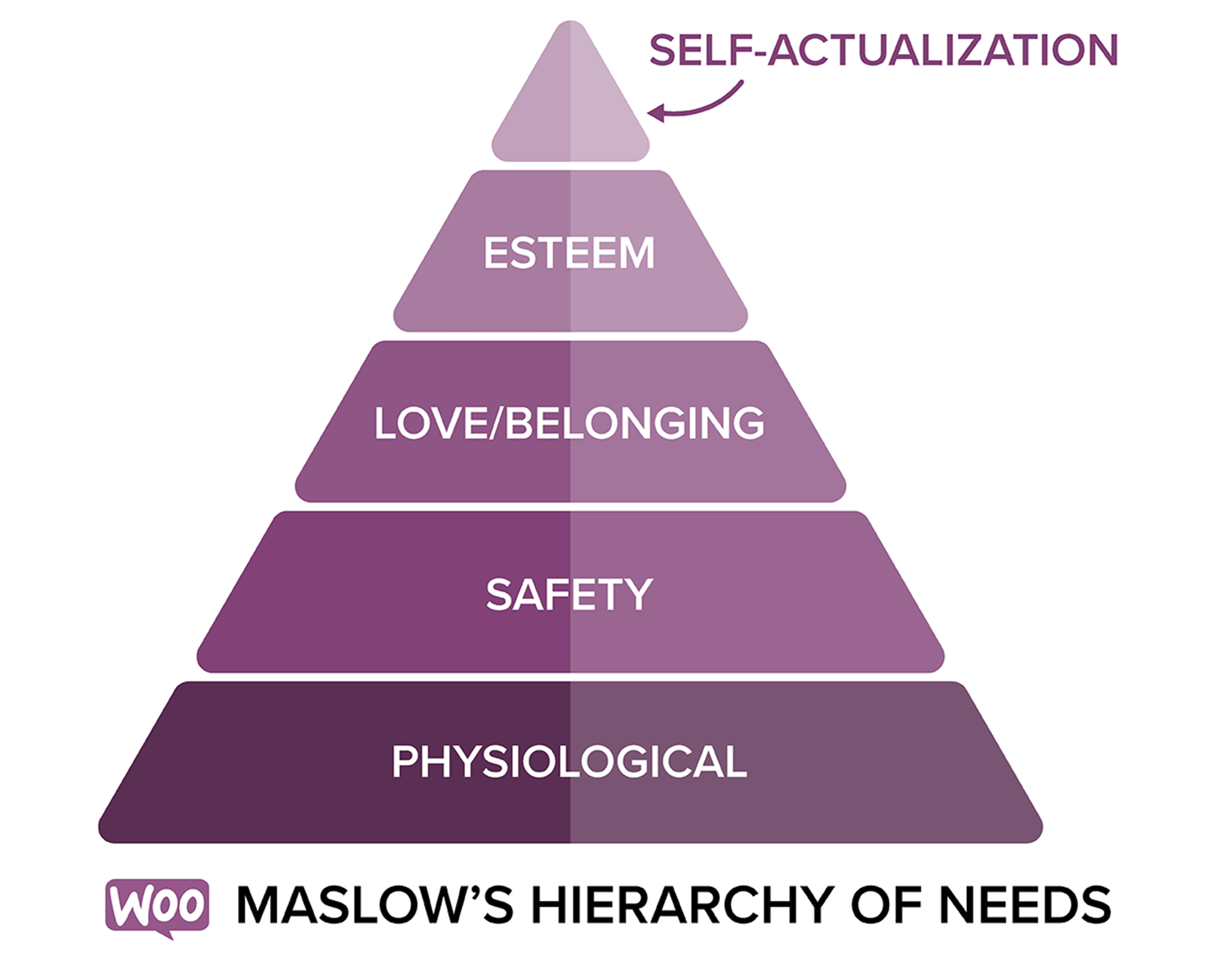
Targeting the Needs of the Consumer
Maslow’s Hierarchy of Needs is a motivational theory utilizing a 5-tier pyramid. In this model, needs at the bottom of the pyramid must be tended to before a person can deal with needs at the top.
Every product relates to at least one psychological need. When you understand the need, you can write product descriptions that connect with your shoppers on a deep, emotional level. The copy will have a more appropriate tone and use words better suited for the mental state of your customer when they’re faced with finding a solution.
For example, if you sell tornado shelters, you’re not really selling a product; you’re selling peace of mind. That is directly related to the Safety Needs level of Maslow’s Hierarchy. While that may be the primary need addressed, good copy often appeals to multiple levels.
Keeping our tornado shelter example in mind, let’s examine how you might appeal to more than one level.
- Physiological Needs – This provides shelter during a storm.
- Safety Needs – This provides peace of mind.
- Love and Belonging – This protects the people that you love.
By keeping in mind the Hierarchy of Needs as you write product descriptions, you dramatically increase the chances that you connect emotionally with your potential customers.
Speaking their Language
Jargon doesn’t sell products. Customers can tell when a product is being overhyped with buzz words and marketing speak. For more effective product descriptions, write copy that uses the language your customers use to describe experiences.
One of the most effective ways to accomplish this is to research what other customers are saying about a product.
Search for product reviews on Google, Amazon, and other sites. Find impactful phrases that reflect the product experience. In many cases, you’ll find customers tend to use the same tone and words or phrases.
Use those words within your product description, especially when describing benefits, to create emotionally-charged, persuasive copy.
Using Sensory Words to Trigger the Subconscious
Sensory words are used strategically in product descriptions to trigger feelings. When you influence the emotional and psychological state of a consumer, they’re more open to purchasing the product.
To achieve this, you need to do more than stuff colorful adjectives into your product copy. Instead, think about the sensory details of your product. Depending on the product, that might include sight, sound, taste, smell, and touch or a combination of some of those.
When customers read these words and phrases, it triggers the sensory areas of the brain.
Éclat Chocolate does an excellent job of triggering the senses in its product descriptions. They make it easy to imagine what the chocolate will taste like without ever taking a bite.
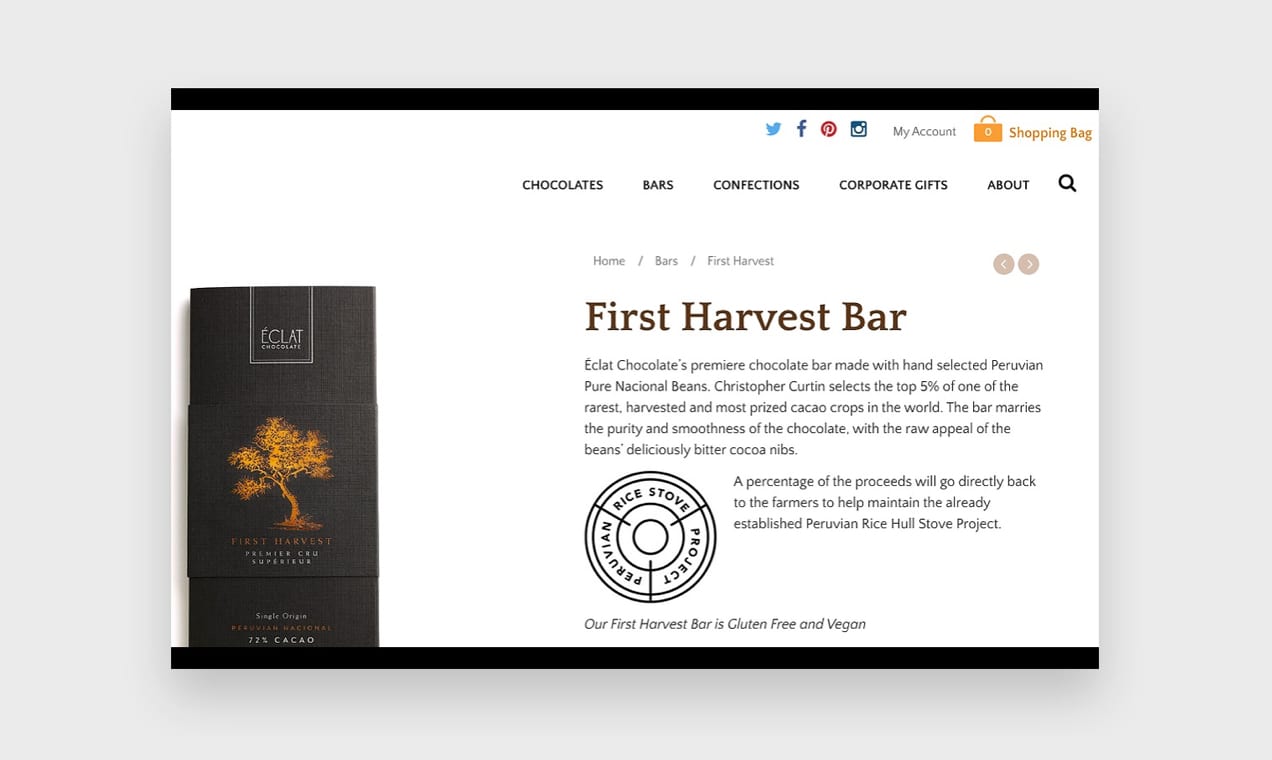
This is important because, as you read, your subconscious processes the sensory words and triggers both thoughts and emotions tied to them.
Imagine tasting a certain flavor of ice cream, seeing the sparkle across fresh snow in the sun, hearing the water lapping and splashing along a smooth sandy shore, or feeling the texture of the warm, wet sand beneath your feet.
Making a subconscious connection is critical in an environment where customers can’t hold products, because research has shown that when we can hold a product, the desire to own it increases dramatically.
This is the same psychology used in crafting menus for restaurants, where sensory words influence customers to purchase more dishes.
Components of a Great Product Description
Writing product descriptions would be a lot easier if we could nail down a universal format, structure, and length.
Unfortunately, what works for one product isn’t necessarily ideal for another.
What makes a product description great will vary based on the type of product you’re selling as well as the audience and industry.
You can see obvious differences when actively comparing:
- Subscription-based products for B2C and B2B
- Simple commodity products
- Foods/consumable products
- Technical/complex products
- High-value products
For example, a simple product like a shirt doesn’t necessarily need a lot of content or benefit statements unless the clothing has unique properties. Compare that to a computer or custom furniture; high value or technical items often need more content to communicate value and the multiple benefits of the product.
Regardless of the type of product, there are some core components vital to writing a good product description.
The Short Description
The short description is the short description of your product that typically appears at the top of the product page.
Next to the title, this short description is the first thing a consumer skims over when they land on the page. So, a good practice is to place the most impactful benefits and persuasive copy here.
This example from Aeropress shows a short description that effectively highlights the top benefits of the product.
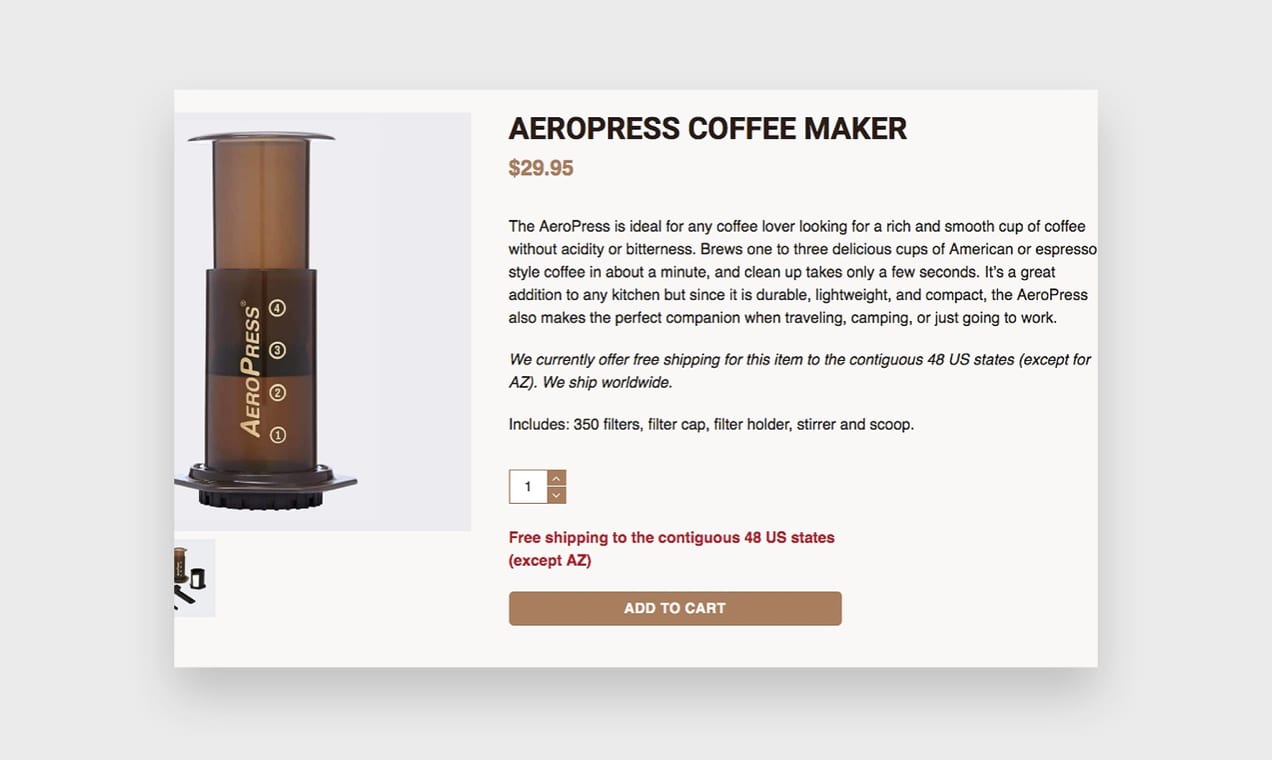
The Long Description
The long description is the space to leverage everything you know about your target audience, using persuasive copy to pull them in and make a strong emotional and psychological connection.
Despite the name, it doesn’t necessarily have to be long. Your product description only needs to be as long as it takes to sell your audience.
The upside is that you’ve got plenty of room to tell a story or dig in with sensory language to captivate the customer.
Here’s an example from Pagoda Classics that uses creative storytelling to leverage the passion and interest of its target audience.
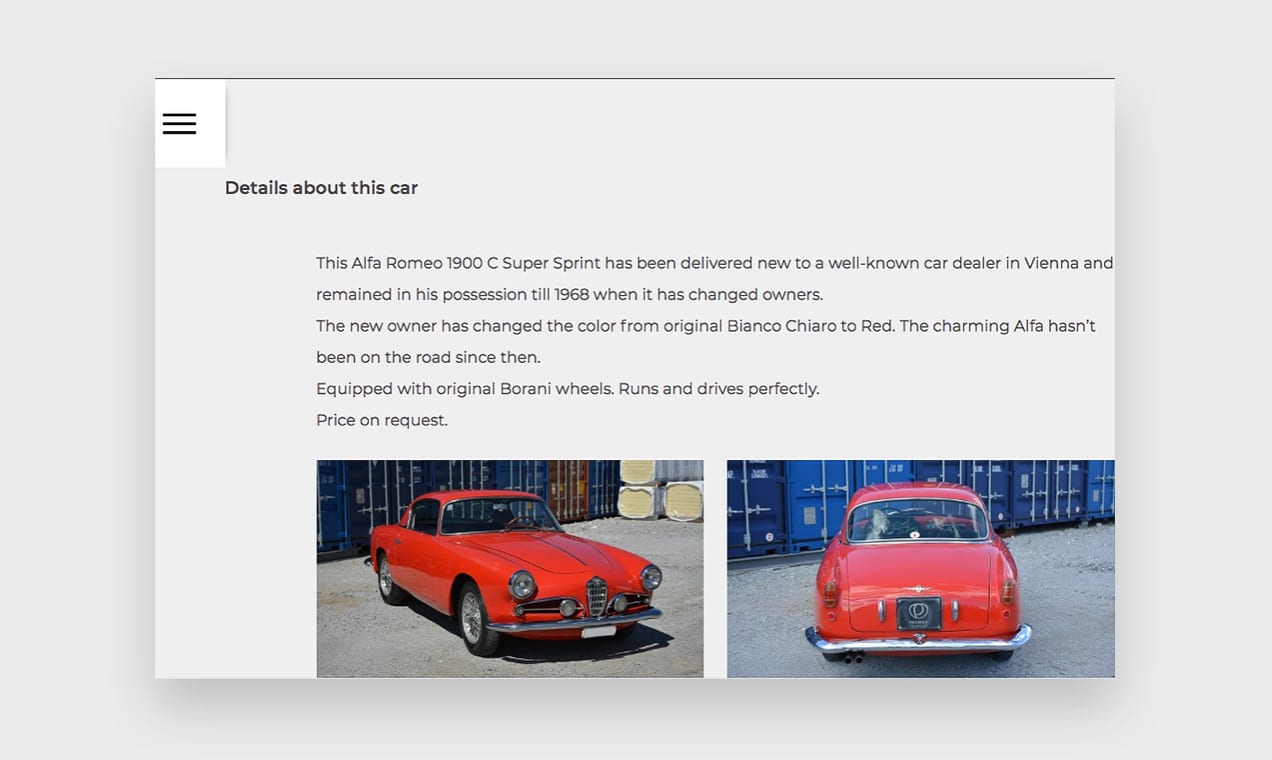
Whether or not you have space for both a long and short product description depends on the template and theme layout of your online store. If you have the option for both in your WooCommerce product page, then make sure you’re taking advantage of them.
The Features and Benefits
Most customers aren’t interested in the general specifications and the mundane features of a product. Customers want to know how those features are going to benefit them and what they’ll get out of using the product.
Every product has features, and every feature has a benefit that details the reason a customer should buy it, or how they’ll benefit from using it.
And there’s no better example of the difference between the drab pitch of a feature and a remarkable benefit than this comparison of the original iPod.
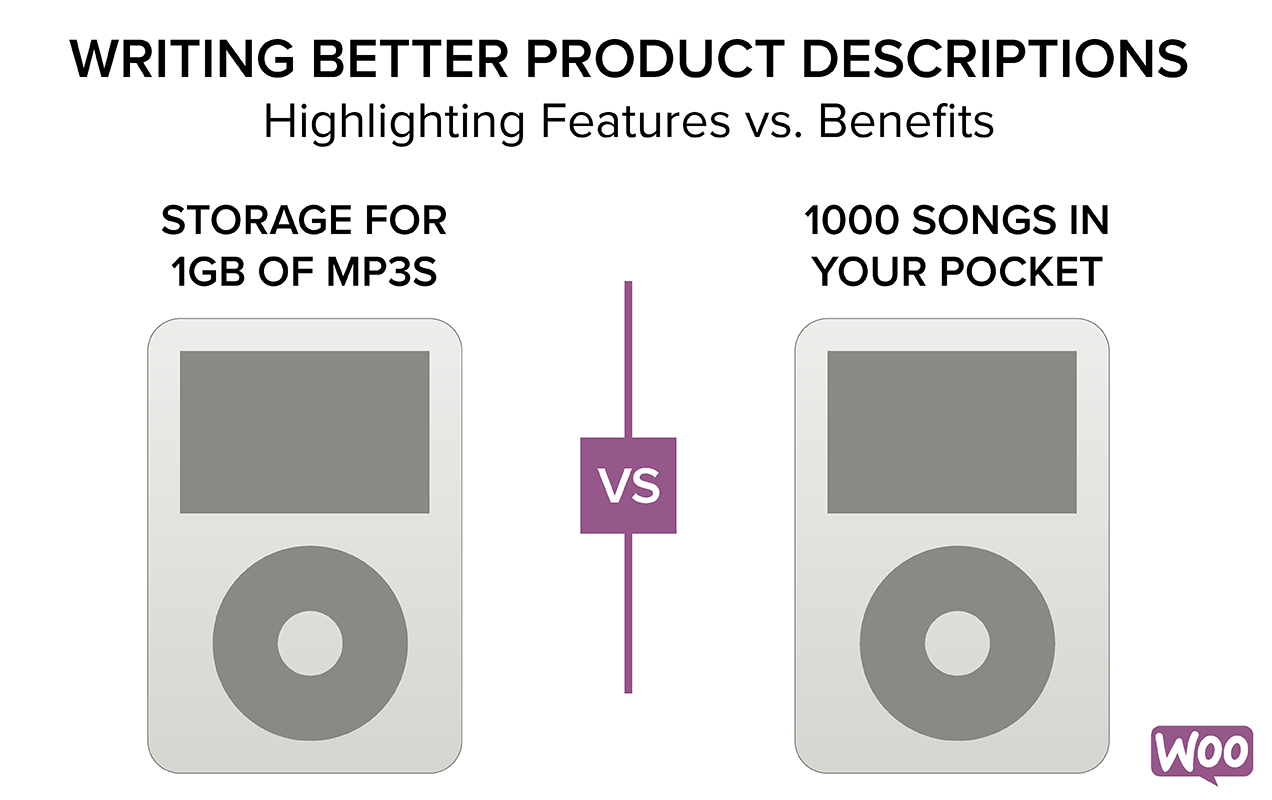
Include a bulleted list on your product pages that highlights key features followed by the benefit of those features. This way, you’re not just selling the product; you’re selling the experience.
GhostBed is a great example of how to transform generic features into a list of value-packed benefit statements.
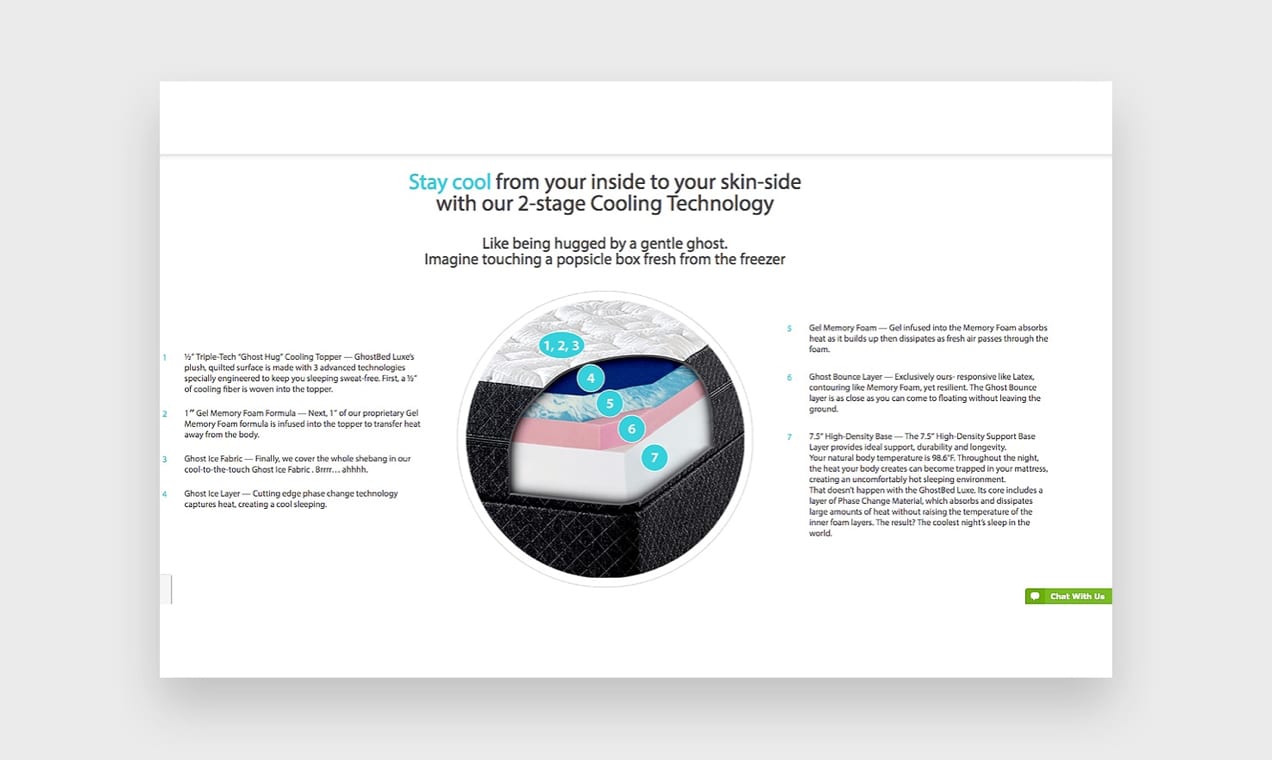
Bonus Tips for Writing Better Product Descriptions
Create Unique Descriptions
Never copy the product description from the manufacturer. If your competitors do this (and they do), you face a duplicate content issue with search engines, which could hurt your rankings. Using these generic descriptions won’t make you stand out or give the search engines any particular reason to show you ahead of your competitors.
Likewise, manufacturers don’t write persuasive copy. They write feature-focused copy. Their generic product descriptions won’t win you any extra conversions.
Don’t Leave Product Pages Blank
Even if you’re selling simple products, there is always a benefit to be had from writing unique and engaging product descriptions. The product photos you have will certainly do their part in convincing a customer to make a purchase, but search engines can’t identify the context of images.
A lack of content certainly won’t answer questions a customer may have.
Start and End with the Most Impactful Information
Before reading in-depth, customers tend to skim over content. According to NNGroup, consumers gloss over the majority of content, focusing mainly on the start of paragraphs and sentences.
When writing your short and long descriptions, don’t waste that first bit of content real estate. Write text that helps them better understand your product and its key benefits.
Open with a strong and memorable value statement.
Keep the Content Short
If you’re passionate about your products, like many retailers, it’s easy to say too much.
While longer benefit statements may help sell certain products (and only testing will prove one way or the other) it’s better to start small.
Try to trim your benefit statements down to a single sentence. Not only does this make it easy to convey value quickly and at-a-glance, those short value statements are easily repeatable, which can help with word-of-mouth from loyal customers.
Formatting Matters
When creating longer descriptions with more details and benefits, it’s vital to format the content in a way that makes it easy to skim but also easily readable when a customer is ready to dig in.
One study from NNGroup found that concise, scannable, and objective copy resulted in 124% better usability.
Achieve this on your product pages by:
- Using bulleted lists
- Limiting paragraphs to 3 sentences
- Using subheadings to break up content
- Formatting pages to place some content modules in a grid pattern
- Including visual elements throughout the product page
- Employing more white space so product copy has room to breathe
Never Stop Testing
Every product description you write should be temporary, only lasting as long as it takes to test its effectiveness. Regularly split test different benefit statements, keywords, persuasive copy, formatting and content length.
Split testing is an essential part of optimizing your product descriptions to improve conversions and reach business goals.
Better Product Descriptions Start with Understanding Your Audience
Writing better product descriptions is as much a creative process as it is a scientific one. A strong understanding of your target audience will help you identify the best words and phrases to creatively weave around features and benefits. Once written, continued testing will help you improve the phrasing and formatting. Using the tips from this article, you’ll be able to tune into the psychology of your target audience to create persuasive product descriptions that will continue to improve conversions in your WooCommerce store.
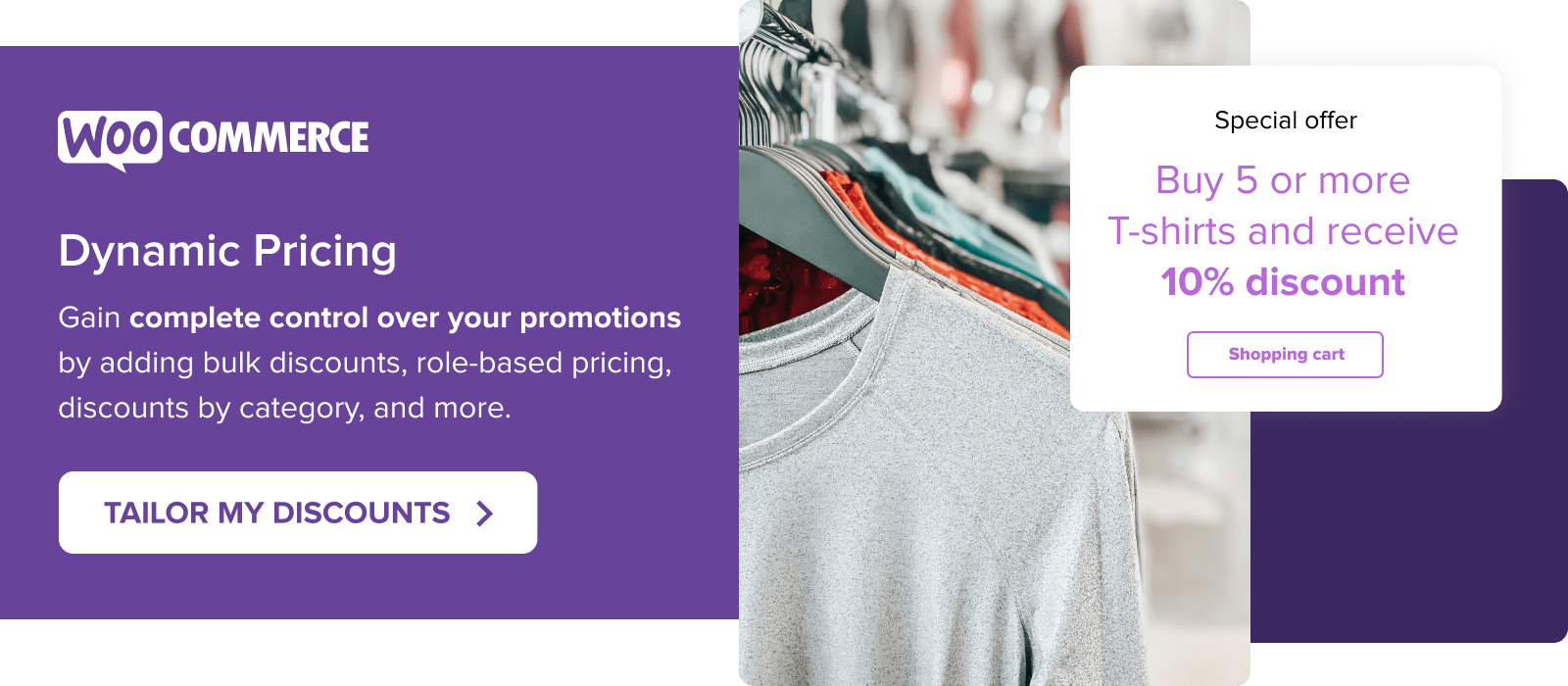
This is a very interesting article. I work in the gambling market and without studying the behavior of the audience, I don’t write a really good text that will interest visitors as much as possible and give them answers to their questions.
The better we know our audience, the better we can work with them. They can also tell you what’s wrong with your text, if you ask them correctly.
My opinion, not only the study of the psychology of behavior can help write really selling content. Interaction with your audience gives a large percentage of success, because they know what they need and what they really want to see in the text.
That’s a really great point, James! We can look at empirical data about our customers all day long, but nothing beats getting direct feedback from them. You can even sell the exact same products as another company but reach your own niche audience simply by framing your product descriptions in a unique way.
i am running comic book site called mangazuki. Now i am thinking to create a subdomain and start selling something new in anime and comics character. Before starting i would like to appreciate you about this post is awesome and perfect for my work. Soon i will launch my shop and i write the product description according to your given guide. Thanks and keep it up.
one last thing, i am from japan and i am little weak in english, so i hope you understand my words about what i mean.
Thanks!
Hi Shang,
I understand your English perfectly! 🙂
I’m so glad that you found this helpful in crafting product descriptions for your anime site. Congrats on expanding your business!
Thanks for this Derek, could we perhaps apply these methods to things other than product descriptions online?
Yes, absolutely! Consumer psychology is useful in a variety of applications, including landing pages, marketing materials for trade shows, and product packaging. I’d love to hear if you end up using these ideas in other ways!